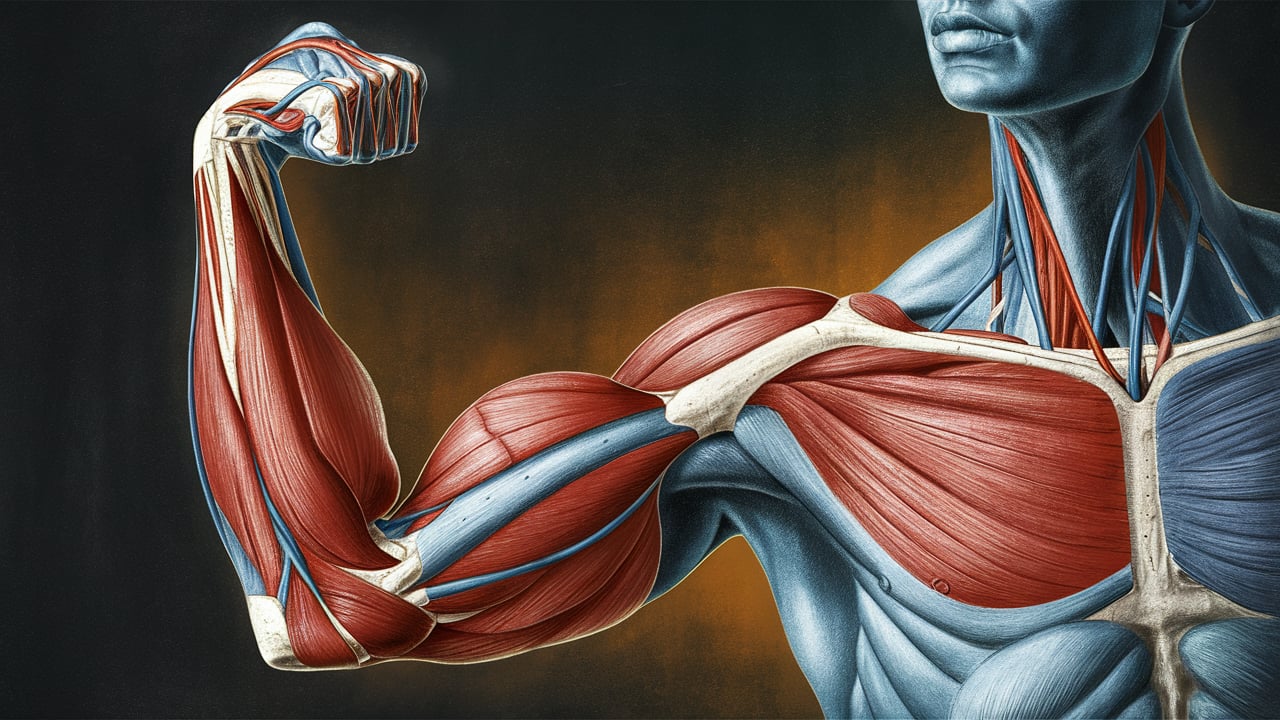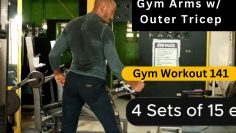The biceps brachii, commonly referred to simply as the “biceps,” are among the most well-known muscles in the human body, often symbolizing strength and fitness. Located in the upper arm, the biceps are crucial for various movements of the arm and shoulder. While the biceps themselves consist of two main muscles, they work closely with other muscles in the arm to facilitate complex movements.
Anatomy of the Biceps
The biceps brachii muscle is composed of two distinct heads:
- Long Head (Lateral Head)
- The long head of the biceps originates from the supraglenoid tubercle, a small projection on the upper part of the scapula (shoulder blade). The tendon of the long head passes through the shoulder joint and the bicipital groove of the humerus (upper arm bone) before joining the short head to form the muscle belly. The long head is positioned on the lateral (outer) side of the upper arm.
- Short Head (Medial Head)
- The short head of the biceps originates from the coracoid process, a bony projection on the front of the scapula. The short head is located on the medial (inner) side of the upper arm and merges with the long head to form the bulk of the biceps muscle.
Both heads of the biceps converge to form a single muscle belly, which then inserts into the radial tuberosity, a bony prominence on the radius (one of the two forearm bones). Additionally, the biceps have an aponeurosis called the bicipital aponeurosis (or lacertus fibrosus), which extends from the muscle and blends into the fascia of the forearm. This structure provides additional stability to the elbow joint and assists in distributing the force generated by the biceps during movement.
Physiology of the Biceps
The biceps brachii play a central role in the movement of the upper arm, particularly in flexion, supination, and stabilization of the elbow and shoulder joints. The physiology of the biceps is closely linked to its structure and function.
1. Flexion of the Elbow
- The primary function of the biceps is to flex the elbow, which brings the forearm toward the upper arm. When the biceps contract, the muscle shortens, pulling the radius bone upward and causing the elbow joint to bend. This action is essential for everyday activities such as lifting objects, bringing food to the mouth, and performing various manual tasks.
2. Supination of the Forearm
- The biceps brachii is also the primary muscle responsible for supination of the forearm. Supination is the rotational movement that turns the palm of the hand to face upward or forward. This movement is crucial for tasks like turning a doorknob, using a screwdriver, or holding a bowl. The biceps achieve this by pulling on the radial tuberosity, which causes the radius to rotate around the ulna, the other bone in the forearm.
3. Stabilization of the Shoulder
- Although the biceps are primarily associated with elbow flexion and forearm supination, they also play a role in stabilizing the shoulder joint. The long head of the biceps, in particular, helps stabilize the shoulder by maintaining the position of the humeral head within the glenoid cavity of the scapula. This is especially important during overhead movements, such as throwing or lifting, where the shoulder joint is under significant stress.
4. Assisting Shoulder Movements
- In addition to its stabilizing role, the biceps assist in shoulder movements, including flexion (raising the arm forward) and abduction (raising the arm to the side). While the deltoid and other shoulder muscles are the primary movers in these actions, the biceps contribute by providing additional force and stability.
Muscles Associated with the Biceps
While the biceps brachii are often the focus when discussing upper arm muscles, they do not work in isolation. Several other muscles interact with the biceps to perform and stabilize various movements.
1. Brachialis
- The brachialis is a deep muscle located beneath the biceps brachii. It originates from the lower half of the humerus and inserts into the coronoid process and tuberosity of the ulna. The brachialis is the primary flexor of the elbow, generating more force than the biceps during this movement. Because it inserts on the ulna, which does not rotate, the brachialis is not involved in supination or pronation of the forearm. However, it works synergistically with the biceps to flex the elbow.
2. Brachioradialis
- The brachioradialis is a superficial muscle of the forearm that extends from the lower humerus to the distal radius. It assists in elbow flexion, particularly when the forearm is in a neutral position (thumb pointing upward). This muscle is engaged during activities like hammering or lifting objects with a grip that places the hand in a neutral position. The brachioradialis also helps stabilize the elbow joint during rapid or forceful movements.
3. Coracobrachialis
- The coracobrachialis is a small muscle located in the upper arm, near the short head of the biceps. It originates from the coracoid process of the scapula and inserts into the medial surface of the humerus. The coracobrachialis assists in flexion and adduction of the shoulder, working with the biceps and other shoulder muscles to raise and move the arm toward the body.
Physiological Adaptations of the Biceps
The biceps, like other skeletal muscles, are capable of adapting to various forms of physical stress, such as resistance training or repetitive activities. These adaptations can include changes in muscle size, strength, and endurance.
1. Hypertrophy
- Hypertrophy refers to the increase in muscle size, which occurs as a result of resistance training. When the biceps are subjected to repeated stress, such as lifting weights, microscopic damage occurs to the muscle fibers. In response, the body repairs these fibers, leading to an increase in their size and the number of contractile proteins (actin and myosin) within the muscle. Over time, this results in larger, stronger biceps. Hypertrophy is often the goal of bodybuilders and athletes who aim to increase muscle mass and strength.
2. Strength Gains
- Along with hypertrophy, resistance training also leads to neurological adaptations that improve the strength of the biceps. These adaptations include increased motor unit recruitment, synchronization, and firing rate, all of which enhance the muscle’s ability to generate force. Strength gains can occur even without significant increases in muscle size, especially in the early stages of a training program.
3. Endurance
- Muscular endurance refers to the ability of the biceps to sustain repeated contractions over a prolonged period. Endurance training, such as high-repetition exercises with lighter weights, enhances the oxidative capacity of the biceps by increasing the number of mitochondria (the energy-producing organelles) and improving blood flow to the muscles. This allows the biceps to perform work for longer durations without fatigue, which is important for activities like rowing, climbing, or sustained manual labor.
4. Recovery and Repair
- The recovery process is essential for the growth and repair of the biceps after exercise. Adequate rest, nutrition, and hydration are crucial for allowing the muscle fibers to repair and grow stronger. Protein intake, in particular, plays a vital role in providing the building blocks (amino acids) needed for muscle repair. Sleep and active recovery techniques, such as stretching and light activity, also support the recovery process.
Common Injuries and Issues
The biceps are subject to various injuries and conditions, especially in individuals who engage in heavy lifting, repetitive movements, or sports that require strong upper body function.
1. Biceps Tendonitis
- Biceps tendonitis is an inflammation of the tendons that attach the biceps muscle to the shoulder and elbow. This condition is often caused by repetitive overhead motions or excessive strain on the biceps tendons. Symptoms include pain and tenderness in the front of the shoulder, particularly when lifting or reaching overhead. Rest, ice, and physical therapy are common treatments for biceps tendonitis.
2. Biceps Tendon Rupture
- A biceps tendon rupture occurs when one of the biceps tendons tears, either partially or completely. This injury is often the result of a sudden, forceful contraction of the biceps, such as during heavy lifting or an awkward fall. A complete rupture of the tendon near the shoulder, known as a proximal biceps tendon rupture, can cause a noticeable bulge in the upper arm, often referred to as a “Popeye muscle.” Surgical repair may be necessary in severe cases, especially for individuals who require full strength and function in their biceps for work or sports.
3. Muscle Strains
- Muscle strains in the biceps occur when the muscle fibers are overstretched or torn, typically due to excessive force or improper lifting techniques. Symptoms of a biceps strain include pain, swelling, and weakness in the upper arm. Mild strains may heal with rest and conservative treatment, while more severe strains may require physical therapy.
Conclusion
The biceps brachii, consisting of two main muscles—the long head and the short head—are essential for various upper body movements, including elbow flexion, forearm supination, and shoulder stabilization. These muscles, along with other associated muscles like the brachialis and brachioradialis, contribute to the strength,








